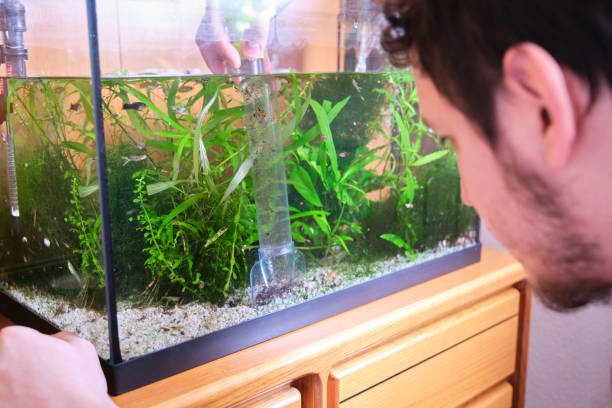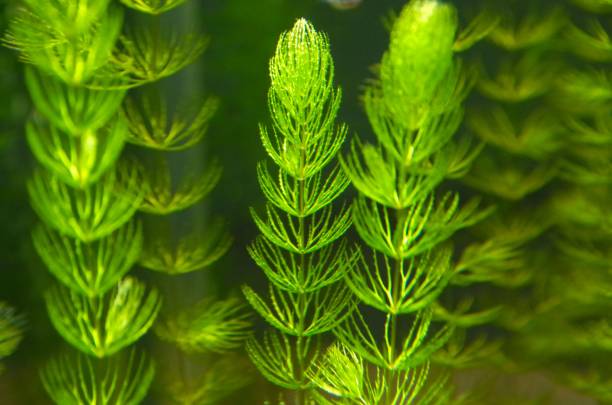Welcome to the fascinating world of aquarium algae, where underwater greenery plays a pivotal role. Algae, often considered a nuisance, brings both benefits and challenges to your aquatic haven.
In the realm of positives, algae serve as a natural food source for certain fish, contributing to a balanced ecosystem. These tiny green organisms also produce oxygen, enhancing water quality for aquatic inhabitants.
However, the downside emerges when algae overstay their welcome, causing cloudy water and obstructing the view of your cherished fish. Excessive algae can outcompete other plants, disrupting the delicate harmony of your aquarium.
The ugly truth about algae includes the notorious green hair algae and stubborn black beard algae. These unwelcome guests thrive in unbalanced environments, seizing the opportunity to overshadow the beauty of your aquatic landscape.
Finding the right balance is key – embracing the good aspects of algae while managing the bad and ugly. Understanding the dynamics of your aquarium’s ecosystem is the first step toward maintaining a vibrant underwater world.
Beneficial Algae Functions
Welcome to the underwater marvel where algae don a superhero cape, playing pivotal roles in aquarium ecosystems. These tiny green powerhouses serve as a banquet for certain fish, supplying essential nutrients and fostering a harmonious environment.
Algae take on the role of nature’s oxygen factories, releasing vital O2 that enhances the overall water quality. In this symbiotic dance, fish breathe easy, and aquariums flourish with life.
Beyond their nutritional prowess, algae act as nature’s filter, purifying water by absorbing excess nutrients. Their voracious appetite for nitrates and phosphates helps combat the potential toxicity lurking in the aquatic habitat.

Aquariums often benefit from the lush greenery provided by algae, offering a pleasing aesthetic while mimicking natural underwater habitats. The vibrant green hues create an appealing backdrop for the aquatic dance unfolding within the tank.
Moreover, beneficial algae contribute to the nitrogen cycle, aiding in the conversion of fish waste into less harmful substances. This natural process ensures a balanced and healthy environment for your aquatic companions.
For hobbyists, embracing algae’s positive aspects means recognizing them as more than just a pesky invader. They become allies in maintaining the delicate equilibrium of your aquarium, supporting the well-being of both flora and fauna.
In conclusion, the beneficial functions of algae extend far beyond their often-misunderstood reputation. As unsung heroes of the aquatic world, these green wonders offer a helping hand in creating and maintaining a thriving, balanced, and beautiful underwater realm for your finned friends.
Challenges of Excessive Algae
In the aquatic symphony of life, excessive algae emerge as the disruptive note, creating challenges for aquarium enthusiasts. As these tiny green invaders multiply, they bring about cloudy water, obscuring the once-clear view of your underwater haven.
The struggle intensifies as algae obstruct the beauty of your carefully curated aquarium, overshadowing vibrant fish and intricate decorations. Excessive growth poses a threat, transforming your aquatic paradise into a murky, unappealing landscape.
Moreover, the rapid proliferation of algae can outcompete other plants, disrupting the delicate balance of your aquarium ecosystem. This imbalance may lead to nutrient deficiencies for other flora, affecting the overall health of your aquatic environment.
Cleaning becomes a constant battle as algae adhere stubbornly to surfaces, requiring diligent maintenance to keep your tank pristine. The chore of scraping and scrubbing becomes a regular routine to combat the unsightly appearance caused by unchecked algae growth.
The negative impact extends beyond aesthetics; excessive algae can deplete oxygen levels, creating an inhospitable environment for fish. This poses a serious threat to the well-being of aquatic inhabitants, emphasizing the urgent need for effective algae management.
Finding the right balance is crucial, employing strategies to control algae growth without harming the rest of your aquarium’s inhabitants. This involves a delicate dance of adjusting lighting, nutrient levels, and implementing algae-eating species to restore equilibrium.
In conclusion, the challenges presented by excessive algae require vigilant care and proactive measures. By understanding and addressing these issues, aquarium enthusiasts can ensure a clear, captivating, and thriving underwater world for their aquatic companions.
Types of Ugly Algae
In the underwater drama of aquariums, certain algae take center stage as the villains, causing havoc. Green hair algae, a notorious troublemaker, invade tanks with their tangled mess, robbing visual clarity and overshadowing the aquatic beauty.
Black beard algae, another unsightly character, attach themselves stubbornly to surfaces, creating a dark, fuzzy appearance. Their resilience makes them a persistent foe, resistant to standard cleaning methods and disrupting the aesthetic appeal of your aquatic realm.
Diatoms, often referred to as brown algae, present a different challenge with their golden-brown coating on various surfaces. While not as visually striking as their green and black counterparts, diatoms still diminish the vibrancy of your aquarium.
Blue-green algae, despite its misleading name, isn’t an algae but a cyanobacterium. This slimy invader forms blue-green layers, emitting a foul odor and posing a threat to the overall health of your aquatic environment.
Green spot algae, characterized by its small, green circular spots on aquarium surfaces, may seem harmless at first. However, its stubborn adherence makes it challenging to eradicate, affecting the pristine appearance of your tank.
Controlling these ugly algae types demands a multifaceted approach, including adjusting lighting, nutrient levels, and introducing algae-eating organisms. Regular cleaning routines and water parameter monitoring become crucial in the ongoing battle against these unwelcome intruders.
In conclusion, understanding the various types of ugly algae is vital for aquarium enthusiasts. Armed with knowledge and proactive measures, you can combat these villains and restore the beauty and clarity of your aquatic masterpiece.
Maintaining Algae Balance
Achieving a harmonious aquatic environment involves mastering the delicate art of algae balance in your aquarium. Striking this equilibrium ensures that the positive aspects of algae are embraced while keeping the negatives in check.
Begin by understanding your aquarium’s unique dynamics, including lighting, nutrient levels, and water parameters. Adjusting these factors can create an environment where beneficial algae thrive, contributing to a balanced ecosystem.
Implementing a consistent cleaning routine is crucial to prevent the accumulation of excess nutrients that fuel algae growth. Regular water changes and substrate cleaning help maintain water quality and discourage unwanted algae proliferation.

Consider introducing algae-eating species into your tank, such as certain fish, snails, or shrimp. These natural allies can help control algae populations, providing a biological solution to maintaining balance in your aquatic habitat.
Mindful lighting management is a key strategy; ensure proper duration and intensity to discourage excessive algae growth. Finding the right balance between light and darkness supports the well-being of your aquarium’s flora and fauna.
Utilize algae-control products cautiously, as some may disrupt the overall balance of your tank. Natural remedies, like adding live plants or using algae-inhibiting chemicals in moderation, can be effective in managing algae without harming your aquatic ecosystem.
Regularly monitor nutrient levels using test kits to proactively address any imbalances that may trigger algae outbreaks. Understanding and responding to changes in water parameters is essential for preventing and managing algae-related issues.
In conclusion, maintaining algae balance in your aquarium is a holistic approach that involves understanding, prevention, and proactive management. By implementing these strategies, you can cultivate a thriving underwater haven that showcases the beauty of your aquatic world while keeping the challenges of excessive algae at bay.
Ecosystem Dynamics Unveiled
Delving into the intricate world of aquariums reveals a captivating tapestry of interconnected ecosystem dynamics. Understanding these dynamics is paramount for cultivating a flourishing aquatic environment.
At the heart of the aquarium’s ecosystem lies the nitrogen cycle, a natural process that transforms fish waste into less harmful substances. Beneficial bacteria play a crucial role in breaking down ammonia, creating a stable and healthy environment for aquatic life.
The introduction of live plants enhances the ecosystem by absorbing carbon dioxide and producing oxygen during photosynthesis. This symbiotic relationship between plants and aquatic inhabitants contributes to improved water quality.
Fish selection influences the delicate balance of the ecosystem; each species has unique requirements and impacts the overall harmony. Compatibility and proper stocking densities play pivotal roles in preventing stress and maintaining a thriving community.
Nutrient levels, particularly nitrates and phosphates, wield significant influence on algae growth. Monitoring and controlling these nutrients through regular water testing and proper feeding practices are essential to prevent algae-related challenges.
Lighting serves as a catalyst for photosynthesis, influencing plant growth and, inadvertently, algae proliferation. Striking a balance in lighting duration and intensity is crucial to support the needs of both plants and fish.
Water circulation ensures uniform distribution of nutrients and oxygen throughout the aquarium, preventing stagnant areas. Efficient filtration systems contribute to maintaining water clarity and removing debris, supporting the overall health of the ecosystem.
Regular observation and proactive adjustments based on the aquarium’s dynamics are vital for long-term success. Recognizing the interconnected nature of elements such as water chemistry, plant life, and fish behavior empowers aquarium enthusiasts to create a thriving and sustainable aquatic habitat.
In conclusion, the dynamics of an aquarium ecosystem are a symphony of interactions. By unraveling these complexities and making informed decisions, enthusiasts can foster a balanced and vibrant underwater world for their aquatic companions.
Conclusion
In the intricate dance of underwater life, the story of aquarium algae unfolds—a narrative of contrasts. The good, represented by algae’s role as a natural food source and oxygen producer, fosters a flourishing aquatic ecosystem.
However, the bad surfaces when algae overstep their boundaries, clouding the once-clear waters and disrupting the visual harmony. Excessive growth becomes an unwelcome guest, threatening the beauty enthusiasts strive to create in their underwater haven.
The ugly side introduces formidable characters like green hair algae and black beard algae, creating visual chaos and challenging the resilience of aquarium keepers. These persistent invaders require strategic intervention to restore the aesthetic balance.
Navigating the nuances of aquarium algae demands a holistic approach. Embracing the positive aspects while managing the challenges involves understanding the ecosystem dynamics. Striking the right balance involves careful consideration of factors like lighting, nutrient levels, and the introduction of algae-eating allies.
In this intricate tapestry, enthusiasts find themselves as stewards of a delicate underwater realm, where vigilance and proactive measures are key. The ever-changing dynamics of an aquarium’s ecosystem necessitate a continuous journey of observation, adjustment, and learning.
In the end, the tale of aquarium algae is one of coexistence and management. With knowledge as their guide, enthusiasts can transform the challenges into opportunities, ensuring a captivating and balanced aquatic showcase. The underwater symphony continues, with the good, the bad, and the ugly playing their roles in the ever-evolving narrative of the aquarium world.





